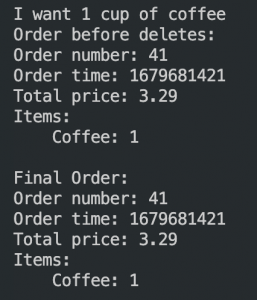Personal Accomplishments
This week I have completed our final presentation and started working on the final poster and report. I have also done more unit tests on the NLP system and the results are attached below. All the simple commands only involving addition or deletions resulted in 100% accuracy; the only test cases which went wrong are the ones where addition and deletion commands appear in the same sentence. Fortunately, based on our requirement for the users to order item-by-item, this complicated sentence should not occur in the use case of our system. The reason why the inaccurate test cases are hard to fix is that different menu items can generate different dependency trees even in the exact same sentence structure. Accounting for one edge case often means giving up on another.
| Trial | Test string | Addition Accuracy | Removal Accuracy | Inaccurate cases |
|---|---|---|---|---|
| 1 | can I have a [menu item (sg)] please | 100% | N/A | |
| 2 | two [menu item (pl)] | 100% | N/A | |
| 3 | two [menu item (sg)] | 100% | N/A | |
| 4 | five beautifully packaged [menu item (pl)] | 100% | N/A | |
| 5 | a box of [menu item (sg)] please | 100% | N/A | |
| 6 | twenty [menu item1 (pl)] and three [menu item3 (pl)] | 100% | N/A | |
| 7 | remove [menu item (pl)] please | N/A | 100% | |
| 8 | i will get rid of [menu item (pl)] | N/A | 100% | |
| 9 | one [menu item (sg)] oh wait can i get rid of a terrible [menu item (sg)] please | 80% | 100% | Hot dog, fries, onion rings |
| 10 | i want three [menu item (pl)] can i delete two [menu item (pl)] | 80% | 100% | Cheeseburger, chicken burger, chicken sandwich |
Schedule
I am on track with our schedule.
Plans for Next Week
I will work with my teammates for the final report, poster and video submission. We will find volunteers to test our system as well.





